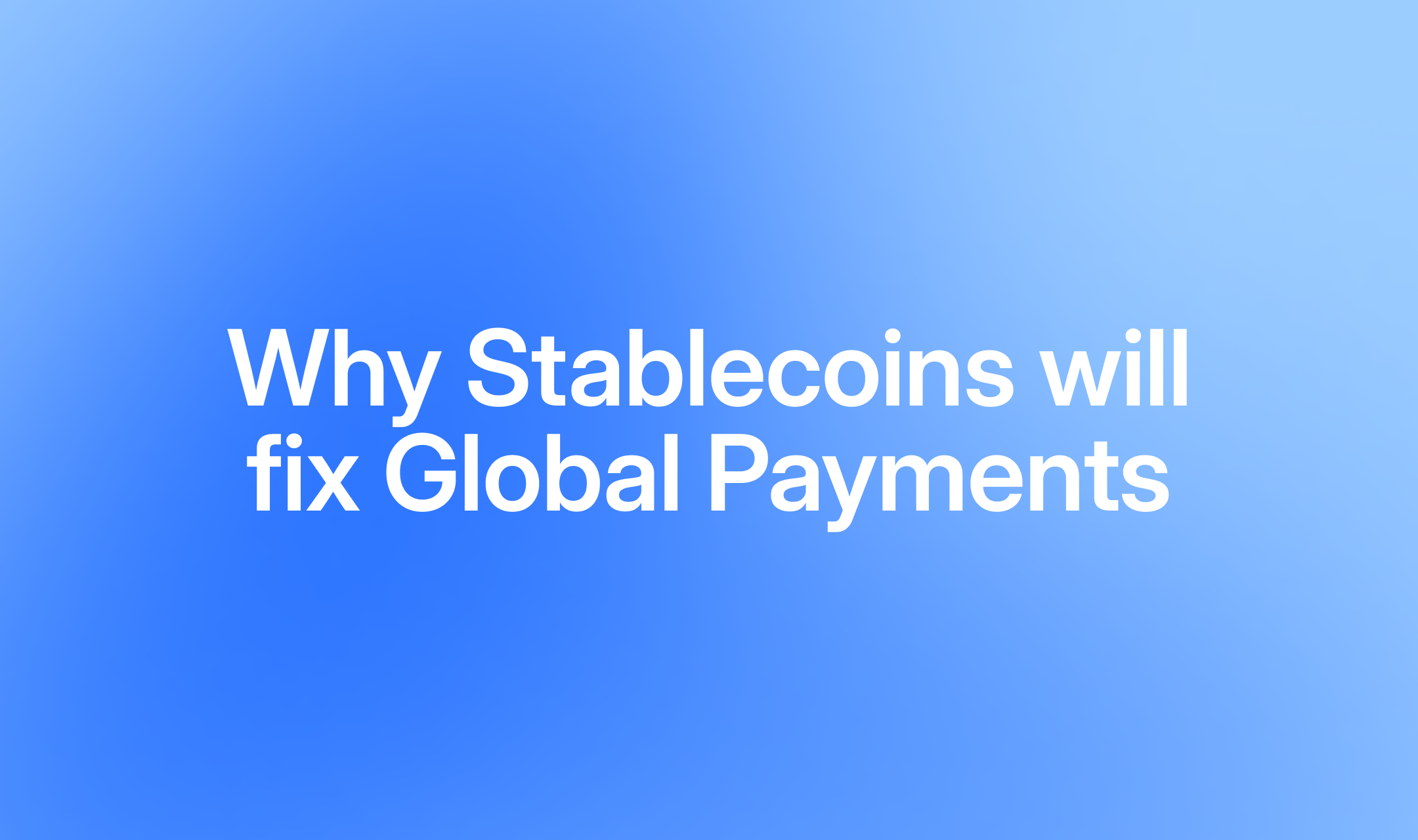Why Stablecoins will fix Global Payments

Cross-border payments cost businesses billions annually in fees and delays. A simple international wire transfer costs at least $25 USD and takes days to settle. For the 685 million people who send remittances home, traditional services charge an average of 6.62% per transaction.
Stablecoins are changing this reality. Fiat-pegged digital assets are enabling 24/7 instant global transfers at a fraction of the traditional cost. Global stablecoin transaction volumes reached $5 trillion by August 2025, with stablecoins now facilitating 3% of global cross-border payments.
How stablecoins solve payment problems
Instant settlement: Payments complete in seconds rather than days, enabling real-time business operations and immediate access to funds.
Dramatic cost reduction: Transaction fees drop from significant percentage-based charges to flat rates under $1, making micro-payments and small transfers so cheap they're still viable.
Global accessibility: Underbanked individuals can now send and receive payments without requiring access to traditional banking infrastructure, or relying on their potentially volatile national currency.
Always available: Unlike traditional banking systems, stablecoin networks operate 24/7 - weekend transaction volumes now regularly exceed weekday rates.
Programmable money: Smart contracts enable conditional, automated transparent payments that are not currently possible with legacy systems. For example, escrow payments that automatically release funds when delivery is confirmed, or milestone-based project payments that trigger instantly when predetermined conditions are met.
Cost comparison: Traditional vs. Stablecoin payments
| Payment Type | Cost (USD) | Speed | Availability |
|---|---|---|---|
| Wire transfer | $25-50 | 1-3 days | Business hours |
| Credit card (international) | 3-5% | Instant | 24/7 |
| Traditional remittance | 6.62% avg | Hours to days | Limited hours |
| Stablecoin | $0.05-$1 | Seconds | 24/7 |
Real transformation in action: Who's adopting stablecoin payments
Everyday consumers: In high-inflation regions, consumers can use stablecoins for daily purchases and savings, protecting purchasing power while accessing global commerce.
For example, imagine Maria, a freelance designer in Argentina who previously lost a significant portion of her income to international transfer fees. By using a stablecoin, Maria can cut the middlemen out and receive payments in USDT directly to her digital wallet. Along with the savings from the reduced transaction fees, Maria can now also access her funds immediately, and has the reassurance that her money will hold a stable value during local currency volatility.
Global enterprises: Major businesses have already started to explore how programmable stablecoins can help automate their processes. For example, Siemens, which is using a programmable stablecoin to automate the company's treasury operations, can now efficiently settle international invoices in real-time without the delays and costs of traditional banking rails.
Remote workers and freelancers: Platforms like TransFi and Parallax facilitate instant global payroll, eliminating FX conversion costs and banking delays.
Developers: Digital platforms are leveraging stablecoins as reliable payment methods to fulfil in-app transactions where ease of transfer and currency stability are essential factors.
NGOs and aid organizations: Charity groups like GiveDirectly are using stablecoins to distribute aid directly, helping them to reach unbanked populations, while ensuring the full transparency of their operations.
These examples reflect the surging adoption of B2B stablecoins, with volumes having surged in the past two years to reach a reported $3 billion USD in 2025.
Overcoming implementation challenges
High fees and slow networks
Solution: TON delivers lighting-fast transactions with ultra-low fees ($0.01-$0.05), and, through its native Telegram integration, enables in-app payments in just a couple of clicks
Complex fiat conversion
Solution: Modern platforms can seamlessly handle regulatory compliant conversion and settlement automatically, making stablecoin adoption simple for businesses and individuals.
Regulatory uncertainty
Solution: Clear frameworks are beginning to emerge --- the EU's MiCA regulation and the US GENIUS Act are providing more comprehensive legal guidelines for stablecoin providers and platforms leveraging stablecoin-based payments.
TON's advantage for stablecoin payments
TON's integration with Telegram creates a distinctive payment environment. With 87 million US users now having access to TON Wallet, sending stablecoins becomes as simple as sending a message.
Key advantages:
-
Massive built-in audience: Telegram's 1B+ users represent the largest potential stablecoin payment network
-
Zero friction onboarding: No separate app downloads or complex wallet setup
-
Ultra-low costs: TON's architecture enables payments for pennies, making micro-transactions practical
-
Instant settlement: Payments confirm in seconds, ideal for real-time commerce
This integration positions TON for mainstream stablecoin adoption, where payments feel like social interactions rather than financial transactions.
Getting started with stablecoin payments
For individuals: User-friendly wallets like Wallet, MetaMask, and Phantom make stablecoin transfers accessible without requiring technical expertise.
For businesses:
-
Choose networks and tokens based on your needs: TON's Telegram integration enables seamless in-app P2P payments.
-
Start with low-value transactions as you build familiarity and work with regulated providers to maintain compliance.
-
Design systems that can scale as the demand for stablecoin payments increases.
The future of payments is programmable, instant, and global. Stablecoins are making that future available today.

